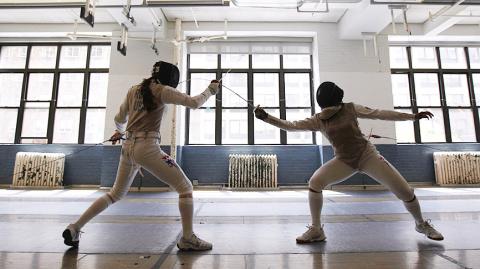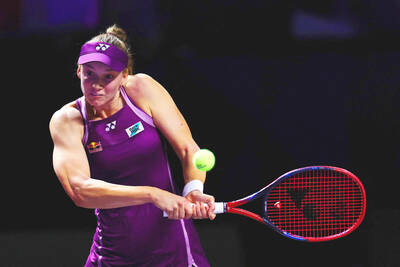Almost 30 years ago, the tight-knit sport of fencing suffered a tragic accident with the horrific death of world and Olympic champion Vladimir Smirnov.
While the Soviet fencer’s death at the Rome World Championships in 1982 shocked the sport to its core, the fatal accident proved to be a turning point in making fencing safer.
Smirnov was fencing West Germany’s Matthias Behr in Rome. Both stood over 1.82m tall and were described by coaches and teammates as massively strong and fast, their attacks akin to an oncoming locomotive.

Photo: Reuters
They attacked each other simultaneously in an attempt to establish an advantage, or what is known in fencing as the “right of way,” Smirnov’s former coach Alexander Perekalsky, 87, said in a recent telephone interview from Moscow.
“Smirnov tried to block Behr’s blade with an upward parry, that Behr avoided. Both collided and Behr’s blade broke on Smirnov’s chest and by inertia he continued forward,” Perekalsky said.
“The broken blade hits a brand new mask and goes through, hitting him above the left eye and into his brain,” he added.
Smirnov died about 10 days later after being taken off life support, his death mourned by the entire fencing world.
Behr left fencing in the aftermath of the accident, but returned to win the foil silver at the 1984 Los Angeles Olympics, and headed Germany’s national fencing training center in Tauberbischofsheim.
Ioan Pop, the international technical director for fencing’s governing body (FIE), said the current standard of safety in the sport owed much to the accident 30 years ago.
“It was absolutely the accident and the death of Smirnov in 1982, in Rome,” said Romanian Pop, who won two Olympic team bronze medals in saber.
Pop is responsible for making sure fencing at the London Olympics is safe as well as enjoyable to watch.
While safety is paramount, the real challenge is to make sure spectators can see the action, no easy task given the tip of a fencing blade is believed to be the second-fastest moving object at the Olympics after the marksman’s bullet.
Massive floor lights wrapping around the fencing area will flash when the wireless electronic scoring equipment is set off by a touch, either on or off the valid target.
Slow-motion instant replay for judges, and new for Olympic spectators this year, makes decisions more transparent. That is a big improvement from the past, when national interests very often hid behind the subjective reasoning of the referee.
And in foil, the lightest of the three weapons that include epee and saber, the bib — or area below the chin — is now a valid target, increasing the pace of a bout.
In an era of ballistic-grade fabric for uniforms, stronger steel, more rigid masks that stand up to 12kg punch tests and the banning of the running attack in saber, safety has improved and injuries severe enough to knock a competitor out of competition remain low.
Despite the dramatic images of blistering clashes with swooping metal weapons and ear-piercing screams of aggression, the sport is significantly safer than American football, soccer or basketball, according to a five-year study by the United States Fencing Association published in 2008.
When compared with a database of collegiate sports injuries, the association’s study, led by chief medical officer Peter Harmer, found injury rates 50 times greater in soccer than in fencing.
Between 1995 and 2005, fatal injuries because of participation in US high school and collegiate football reached 143,63 deaths for basketball and 20 for soccer. In the past 100 years there have been no reported deaths in US fencing.
Worldwide since Smirnov, Harmer said there are just seven confirmed fatalities.

ANFIELD BLUES: Kylian Mbappe arrived at Anfield on a run of 21 goals in 17 games, but he managed just three attempts in the match, none of them hitting the target Kylian Mbappe has been nearly unstoppable this season, but he hit a roadblock in their UEFA Champions League match at Anfield on Tuesday. For the second year running, the Real Madrid forward had a night to forget at Merseyside as Liverpool won 1-0. Mbappe looked a shadow of the player who has been tearing defenses apart all season. “We were lacking that threat in the final third,” said Madrid coach Xabi Alonso, without naming Mbappe individually. The FIFA World Cup winner for France rarely looked capable of finding a breakthrough against a Liverpool team who have been so defensively fragile for much of the

LOCAL SUCCESS: In the doubles, Taiwan’s Hsieh Su-wei and Jelena Ostapenko of Latvia defeated Italians Sara Errani and Jasmine Paolini in straight sets Elena Rybakina on Monday punched her ticket to the WTA Finals last four with an impressive 3-6, 6-1, 6-0 victory over second seed Iga Swiatek in round-robin play in Riyadh. After cruising past Amanda Anisimova in her opener on Saturday, Rybakina claimed her second win of the week to guarantee herself top spot in the Serena Williams Group. Anisimova on Monday rallied back from a set and a break down to triumph 4-6, 6-3, 6-2 in her all-American battle with seventh seed Madison Keys, who has been eliminated from the competition. “Madi was playing so well, it was quite a battle out there,”

Erling Haaland on Sunday scored twice to propel Manchester City up to second in the English Premier League with a 3-1 win over AFC Bournemouth. The Cherries started the day in second thanks to the longest unbeaten run in the English top flight, but Andoni Iraola’s side were undone by the scintillating form of the Norwegian striker, who took his tally to 13 Premier League goals in 10 games. Haaland’s relentless streak is maintaining City’s title challenge as they reduced the gap to leaders Arsenal back to six points and edged one point ahead of Liverpool, who they face at the weekend. “Important

For almost 30 minutes, Vitomir Maricic did not take a breath. Face down in a pool, surrounded by anxious onlookers, the Croatian freediver fought spasming pain to redefine what doctors thought was possible. When he finally surfaced, he had smashed the previous Guinness World Record for the longest breath-hold underwater by nearly five minutes. However, even with the help of pure oxygen before the attempt, it had pushed him to the limit. “Everything was difficult, just overwhelming,” Maricic, 40, told reporters, reflecting on the record-breaking day on June 14. “When I dive, I completely disconnect from everything, as if I’m not even there.